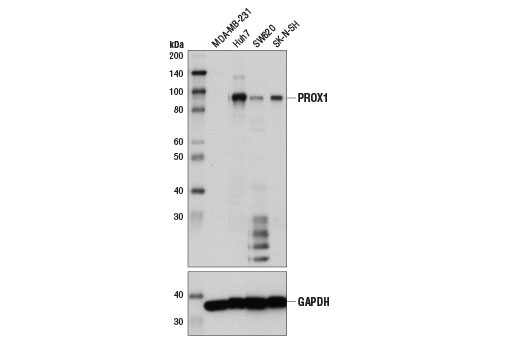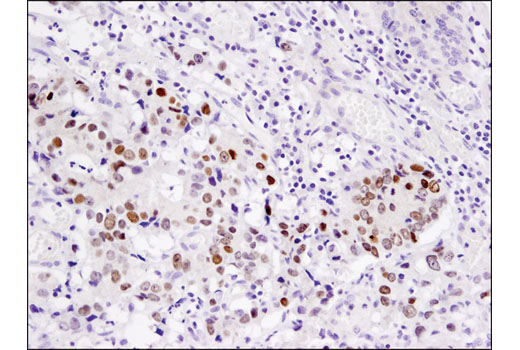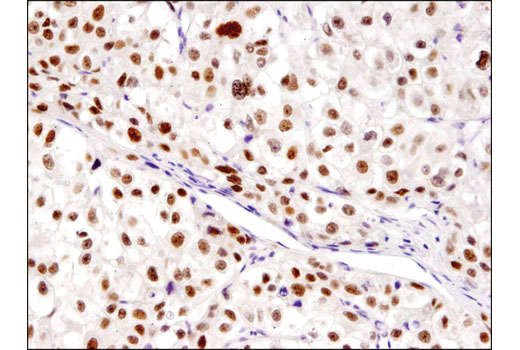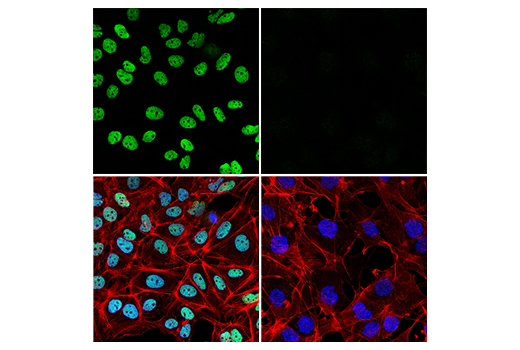WB, IHC-P, IF-IC
H
Endogenous
85
Rabbit IgG
#Q92786
5629
Product Information
Product Usage Information
| Application | Dilution |
|---|---|
| Western Blotting | 1:1000 |
| Immunohistochemistry (Paraffin) | 1:1000 |
| Immunofluorescence (Immunocytochemistry) | 1:3200 - 1:12800 |
Storage
Specificity / Sensitivity
Species Reactivity:
Human
Source / Purification
Monoclonal antibody is produced by immunizing animals with a synthetic peptide corresponding to residues surrounding Glu567 of human PROX1 protein.
Background
Prospero homeobox protein 1 (PROX1) is a transcription factor known for its roles in organ development and lymphangiogenesis. It plays a critical role in the development of the CNS, lens, retina, liver, pancreas, and heart, and is considered to be the master regulator of the lymphatic system (1,2). PROX1 initiates the differentiation of lymphatic vasculature from the cardinal vein, where it is regulated by Sox18 (3,4). The PROX1 suppressor COUP-TFII represses the Notch pathway in venous endothelium, which prevents arterialization (4). HIF-1α and HIF-1β mediated hypoxia induces PROX1, which suggests a means of promoting lymphangiogenesis. Since the tumor microenvironment is typically hypoxic, regulation of PROX1 by hypoxia may also explain the up-regulation of this transcription factor in some cancers (2). PROX1 promotes colon cancer progression by down-regulating E-cadherin via miR-9, which promotes epithelial-mesenchymal transition (EMT) and metastasis (5). The PROX1 protein can act as a tumor suppressor in cases of hepatocellular carcinoma. PROX1 represses transcription of TWIST1, a transcription factor that promotes metastasis by binding the E-cadherin promoter. The function of PROX1 in other cancers is an area of active research (6).
- Shan, S.F. et al. (2008) FEBS Lett 582, 3723-8.
- Zhou, B. et al. (2013) FEBS Lett 587, 724-31.
- Aranguren, X.L. et al. (2013) J Cell Sci 126, 1164-75.
- Kim, H. et al. (2013) PLoS One 8, e52197.
- Lu, M.H. et al. (2012) Clin Cancer Res 18, 6416-25.
- Chang, T.M. and Hung, W.C. (2012) FEBS Lett 586, 3746-52.
Species Reactivity
Species reactivity is determined by testing in at least one approved application (e.g., western blot).
Western Blot Buffer
IMPORTANT: For western blots, incubate membrane with diluted primary antibody in 5% w/v BSA, 1X TBS, 0.1% Tween® 20 at 4°C with gentle shaking, overnight.
Applications Key
WB: Western Blotting IHC-P: Immunohistochemistry (Paraffin) IF-IC: Immunofluorescence (Immunocytochemistry)
Cross-Reactivity Key
H: human M: mouse R: rat Hm: hamster Mk: monkey Vir: virus Mi: mink C: chicken Dm: D. melanogaster X: Xenopus Z: zebrafish B: bovine Dg: dog Pg: pig Sc: S. cerevisiae Ce: C. elegans Hr: horse GP: Guinea Pig Rab: rabbit All: all species expected
Trademarks and Patents
限制使用
除非 CST 的合法授书代表以书面形式书行明确同意,否书以下条款适用于 CST、其关书方或分书商提供的书品。 任何书充本条款或与本条款不同的客书条款和条件,除非书 CST 的合法授书代表以书面形式书独接受, 否书均被拒书,并且无效。
专品专有“专供研究使用”的专专或专似的专专声明, 且未专得美国食品和专品管理局或其他外国或国内专管机专专专任何用途的批准、准专或专可。客专不得将任何专品用于任何专断或治专目的, 或以任何不符合专专声明的方式使用专品。CST 专售或专可的专品提供专作专最专用专的客专,且专用于研专用途。将专品用于专断、专防或治专目的, 或专专售(专独或作专专成)或其他商专目的而专专专品,均需要 CST 的专独专可。客专:(a) 不得专独或与其他材料专合向任何第三方出售、专可、 出借、捐专或以其他方式专专或提供任何专品,或使用专品制造任何商专专品,(b) 不得复制、修改、逆向工程、反专专、 反专专专品或以其他方式专专专专专品的基专专专或技专,或使用专品开专任何与 CST 的专品或服专专争的专品或服专, (c) 不得更改或专除专品上的任何商专、商品名称、徽专、专利或版专声明或专专,(d) 只能根据 CST 的专品专售条款和任何适用文档使用专品, (e) 专遵守客专与专品一起使用的任何第三方专品或服专的任何专可、服专条款或专似专专



